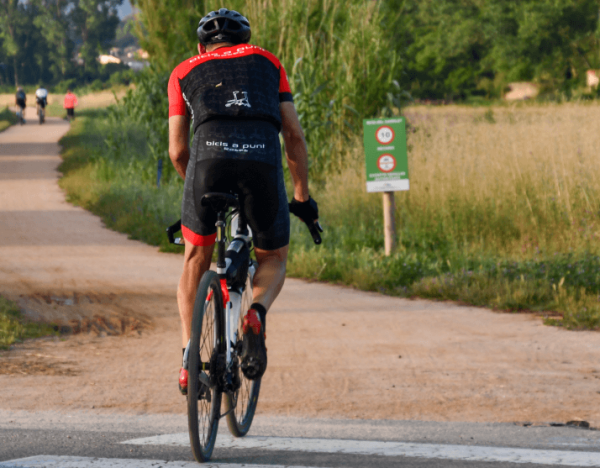Gravel has overcome its most difficult phase, leaving behind the connotations of being a mere trend, to consolidate itself as an established discipline with a large number of followers – a jump that many other cycling variants have never achieved. But Gravel is here to stay, owing to the fact that it is a logical, functional and fun way of understanding cycling. Its origins are far removed from competition and it has managed to position itself somewhere between road cycling and mountain biking, attracting fans of both disciplines.
In fact, Gravel can be interpreted in many different ways, demonstrating the wide range of possibilities that have opened up after having gained ground. The essence of Gravel is based on riding bikes that share a similar design to road bikes but on terrain that’s poles apart from tarmac. In fact, the evolution and popularisation of Gravel owes much to new technologies. The Gravel concept is nothing new, but until recently the gear on offer has made it inaccessible for most users. What we now understand as Gravel was torture for the better part of potential riders. However, several factors have played a key role in the creation of bicycles that make off-road easier for bikes with thin wheels and curved handlebars.
One of the main factors is tubeless tyres. Thanks to tubeless and puncture-proof tyres, flat tyres (a constant nuisance for users riding with thin tyres and inner tubes on rough terrain) are a thing of the past, much like they have been for mountain bikes for several years now. Disc brakes are the other mainstay of today’s Gravel bicycles, those of which have helped bring thousands of users around the world in touch with the discipline. Soft, powerful, adjustable, constant and safe braking, regardless of the weather, has broken down barriers in the adoption of Gravel bicycles.
Behind these two basic pillars of Gravel, in terms of technology, are now countless specific advances: from handlebars specially designed for Gravel, to frames with geometries that differentiate them from what, until recently, were their counterparts: Cyclocross bicycles. If maximum agility, reactivity and speed is the aim of Cyclocross, safety and stability is the order of the day for Gravel. Gravel bikes generally have a higher wheelbase, a longer chainstay length and a more relaxed steering axis angle. If we add in the fact that they don’t have to comply with the maximum tyre width rule enforced by the UCI for Cyclocross, designers are able to create frames with more space for the wheels, which is where the trend that sets Gravel apart comes in: the possibility of using 700c wheels with relatively narrow tyres, or using 650b (27.5 in) wheels with much wider tyres.
The difference between these two possible wheel configurations is huge. Mount a 700c wheel with Gravel tires and you’ll have a less comfortable bicycle with decreased rolling resistance. Put tyres reaching up to 2.2 inches on 650b wheels and you’ll have wheels that offer additional grip and, above all, comfort. Gravel users riding on tougher terrain often opt for the 650b, while 700c users tend to stick to smoother sections or longer stretches of road. All these features, which are characteristic of authentic Gravel bikes, can be found in models such as the recently unveiled Basso Palta, a model that combines different Gravel-bike technology and which Sea Otter Europe Costa Brava Girona visitors will be able to witness in action.
All types of users
Gravel encompasses a wide range of users: from people looking for an uncomplicated and simple bicycle for efficiently tackling long journeys combining tracks and tarmac, to the new generation of Gravel enthusiasts, for whom each ride on this type of bicycle has become a true ritual that goes beyond the ride itself. The latter has helped inspire the emergence of top-of-the-range Gravel models. They stand for attention to detail and not only look for the best materials for their bicycles, but also want their experience to be as premium as their gear. This has allowed the coolest Gravel bikes to make their way onto the market. All over the world travel companies and amazing events, which normally have little to do with competition and are more focused on experiences, are even associating themselves with the discipline. As such, Gravel encompasses everything from driven beginners to a prominent group seeking a unique experience.
LAZER CENTURY GRAVEL JOURNEY
The rise of Gravel is reflected in the sports programme of Sea Otter Europe Costa Brava Girona. There will be a double helping of Gravel at the 2019 edition, with one event on the Saturday and another on the Sunday. The Lazer Century Gravel Journey will get these two days of Gravel in Girona underway and will also mark the centenary of Lazer, an iconic brand specialising in bicycle helmets. Registration will open soon, but in the meantime find more information at www.lazergravel.seaottereurope.com
THE GIRONA GRAVEL RIDE CONTINUES TO TRIUMPH
On Sunday it will be the turn of the Basso Bikes Girona Gravel Ride by Bioracer. Across 75 km, riders will be able to explore the heart of Les Gavarres, a region that has proved to be perfect for Gravel riders and is a must-do destination for many fans of the discipline. The event is a great way to get a real feel for the region whilst covering all types of terrain. The province of Girona has been making in-roads in the Gravel world for some time now, so much so that it has become one of the favourite meeting points for gravel riders from all over the planet. This is demonstrated by the fantastic network of shops, events and brands related to Gravel that are based in the region. Registration is now open and you can find more information at www.gironagravelride.seaottereurope.com
Sea Otter Europe Costa Brava Girona will once again be the perfect place to discover what Gravel is all about. From the best gear, exhibited at the festival’s extensive fair, to the discipline live in action with two new Gravel events. Would you dare miss it?







